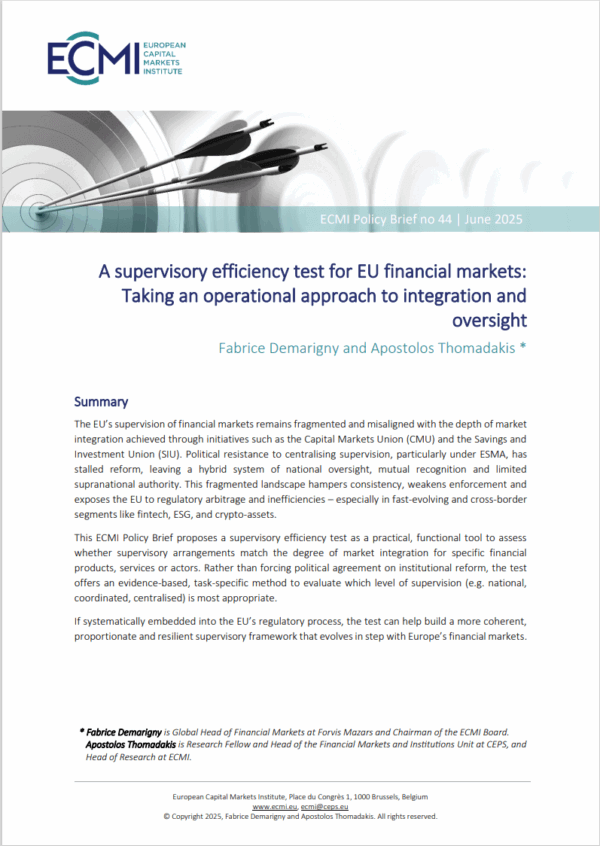Author: Daniel Gros
The European Commission has now tabled ‘enabling’ legislation for the creation of ‘SBBS’, sovereign bond-backed securities. The official purpose is to allow financial markets to create a ‘safe asset’, which should be used by banks instead of government bonds.
Enabling SBBS is useful, but it remains unlikely that they will be widely adopted. Creating a safe asset out of (sometimes) risky government bonds requires a complicated legal structure under which a Special Purpose Vehicle (SPV) issues two new securities, one that would take any ‘first loss’ and another, a more senior one, that would be extremely unlikely to ever experience a loss. Unfortunately, this approach, which is called tranching, has no track record in the market for public debt.
It is thus highly uncertain whether SBBS will be widely adopted. In order to have a better chance of a wider move towards diversification, the Commission should have extended the ‘enabling’ approach to existing instruments, namely normal investment funds, which do not involve tranching. There already exists many funds that combine euro area government debt in a single basket, relying on an existing legal framework, widely used by market participants today. The Luxembourg or Irish UCITS (Undertaking in Collective Investments in Transferable Securities) or ETFs (Exchange Traded Funds) are leading, globally recognised frameworks for such funds with hundreds of billions of euros outstanding and traded. It is difficult to understand why the Commission has not extended the ‘look-through’ approach to all funds, which invest only in euro area government debt.
The essence of the Commission’s proposal makes sense: Banking regulation should accord equal treatment to direct holdings of (euro area) government debt and holdings of investment funds, based only in such debt. Regulation should thus ‘look-through’ the legal structure of these funds. But there is little reason why this look-through approach should be applied only to SBBSs. Moreover, the Commission also proposes to treat the junior or first-loss tranche of the SBBSs in the same way as government debt (and the senior, safe tranche) is treated. This does not make sense since the junior tranche of an SBBS is clearly more risky than a single government bond.
The reason the Commission limited the look-through approach to SBBS is that it thinks that the euro area needs a safe asset. This is a highly debatable proposition. The banking system of the euro area can be stabilised even without creating a new ‘safe’ asset. The real problem is the concentration of risk on bank’s balance sheets in the form of large holdings of bonds of the home sovereign. Diversification should be the first priority. But the current regulatory framework hinders diversification of sovereign risk because existing investment funds of euro area government bonds are treated as if they were much less safe and liquid than the individual government bonds themselves.
The solution thus does not require SBBS. All that is required is that the existing rules followed by regulators should be tweaked so that regulated funds that invest only in euro area government securities are treated in the same way that the underlying government bonds are treated (the look-through approach).
This applies in particular to two key issues: capital and liquidity requirements. As long as government bonds have a zero-risk weight (under the standard Basel approach), euro area banks should not have to hold any additional capital on holdings of funds based only on euro area government securities.
The same treatment should also apply to the liquidity cover ratio (LCR), which obliges banks to hold a buffer of cash or liquid high-quality securities. Investment funds (or ETFs) of euro area government bonds should be put into the same liquidity category as government bonds themselves.
Moreover, as shown in a companion Policy Brief, diversified funds of the debt of many countries have a more stable market value than even the safest individual country bond. They should thus become the preferred instrument to satisfy liquidity needs.
A further step could be that funds that contain euro area government bonds in proportion to the capital key in the ECB should be recognised as ‘diversified’ and thereby exempted from the large exposure limits.
Daniel Gros is Director of CEPS. The views expressed in this contribution are those of the author’s alone and do not necessarily reflect the view of CEPS. As an institution, CEPS takes no official position on questions of EU policy.
CEPS Commentaries offer concise, policy-oriented insights into topical issues in European affairs.
© CEPS 2018












